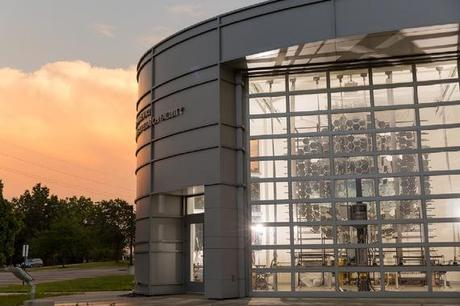A massive 100 year old U.S. Steel mills of Gary, Indiana, used to forge heavy metal for millions of carbon-spewing cars. Now, 30 miles away at Valparaiso University, scientists have built a solar-powered, high-tech furnace to test technologies they hope one day will refine lightweight, low-carbon magnesium for automotive components as well as produce greenhouse gas-free hydrogen to power the vehicles.
“Our goal is to produce magnesium with 90 percent less fossil fuel energy and 93 percent less carbon emissions,” says Scott Duncan, a professor of mechanical engineering at Valparaiso. His team won a $2.3 million Department of Energy grant to develop the process. The National Science Foundation awarded Valparaiso $300,000 for the hydrogen project.
The technologies remain in their infancy but are a sign that renewable energy is moving beyond generating electricity to replacing fossil fuels in energy-intensive manufacturing.
Automakers, for instance, are under the gun to comply with federal fuel economy regulations that require their fleets to achieve an average 54.5 miles per gallon by 2025. One way to meet that mandate is to build lighter vehicles. (Thus Chrysler is backing the Valparaiso solar magnesium effort.) Magnesium, for instance, is about 35 percent lighter than aluminum, notes Duncan. The catch: It’s energy-and-carbon intensive to produce and more than two-thirds of magnesium alloy currently is made in China.
A solar furnace could make green magnesium. Here’s how it works: On Valparaiso’s campus, a 20-foot-by-20-foot mirror mounted on a pedestal a sits outside the oval-shaped building the houses solar furnace – which is one of only five that have been built in the U.S. The mirror, called a heliostat, resembles those deployed by the hundreds of thousands at solar thermal power plants to focus intense sunlight on a liquid-filled boiler that sits atop a tower. (The resulting steam drives an electricity-generating turbine.)

Valparaiso’s heliostat instead tracks the sun and beams light into the building through louvers where it strikes a solar concentrator made up of 306 smaller mirrors. The concentrator magnifies the light’s intensity and focuses it on the solar furnace (also called a reactor) to produce temperatures in excess of 3,000 degrees Fahrenheit.
<div><a href=”http://pubads.g.doubleclick.net/gampad/jump?iu=%2F4624%2FTheAtlanticOnline%2Fchannel_technology&t=src%3Dblog%26by%3Dtodd-woody%26title%3Dthis-sun-powered-furnace-can-reach-3-000-degrees%26report%3Dthe-great-energy-shift-part-2%26pos%3Din-article&sz=300×185&c=337672849&tile=3″ title=””><img src=”http://pubads.g.doubleclick.net/gampad/ad?iu=%2F4624%2FTheAtlanticOnline%2Fchannel_technology&t=src%3Dblog%26by%3Dtodd-woody%26title%3Dthis-sun-powered-furnace-can-reach-3-000-degrees%26report%3Dthe-great-energy-shift-part-2%26pos%3Din-article&sz=300×185&c=337672849&tile=3″ alt=”” /></a></div>Combining magnesium oxide with molten salt and then heating the mixture at high temperatures produces magnesium metal. “Put a little electricity in there and magnesium will float to top,” says Duncan.
Typically, burning coal or another fossil fuel generates those high temperatures. The Valparaiso team aims to use free solar thermal energy instead. So far they’ve made magnesium metal in the laboratory using electric heaters. If all goes well, Valparaiso plans to be making the metal in the solar furnace by the end of next year.
“Enabling [magnesium’s] widespread use in vehicles – without compromising performance or safety – would substantially reduce fuel consumption and CO2 emissions from transportation,” the Department of the Energy said in a statement announcing the grant to Valparaiso.
Powering cars with hydrogen would zero out those automotive carbon emissions and carmakers have already started to roll out fuel cell vehicles in California. Fuel cells convert hydrogen into emissions-free electricity that is used to operate the vehicle’s motor.
Most hydrogen, though, is derived from a fossil fuel – natural gas. Hydrogen can be also be produced through a process called electrolysis where an electric current splits water molecules into hydrogen and oxygen. Use solar panels to generate that electricity and, voilà, you’ve got renewable hydrogen.
Robert Palumbo, a professor of mechanical engineering at Valparaiso, and his collaborators at Sandia National Laboratory, think tapping solar thermal energy would be an even more energy-efficient way to make hydrogen.
The big idea: Use a solar furnace to heat iron oxide to 2,550 degrees Fahrenheit to create a material that when dropped in water acts as a catalyst to produce hydrogen. No electricity needed. Palumbo imagines building solar reactors in the sun-drenched desert Southwest of the U.S. to make the catalyst, which would then be shipped to cities to produce hydrogen. The spent catalyst then would be transported back to the desert to be reused.
“By doing it the way we’re doing it, we’re reducing the amount of energy needed to make hydrogen,” says Palumbo.
He’s unsure at this point whether solar thermal electrolysis would ultimately be cheaper, given the transportation costs. But look to the industrial heartland to birth such innovations as much as Silicon Valley.
